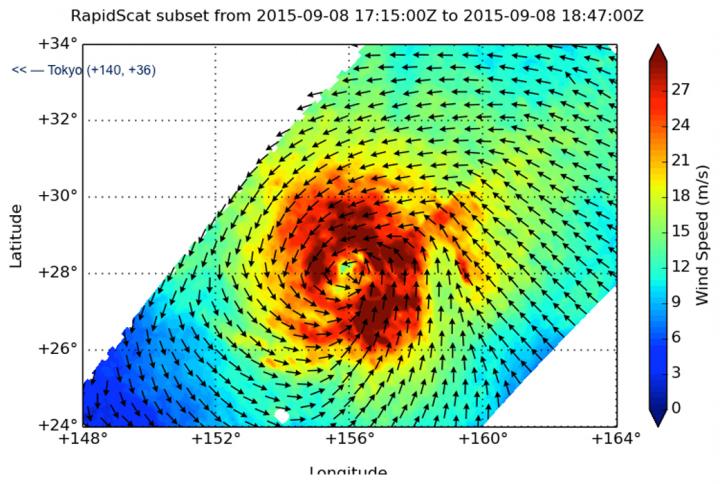NASA's RapidScat sees Typhoon Kilo hold strength

RapidScat showed that Kilo's tropical storm-force winds extended between 170 to 240 nautical miles from the center and strongest sustained winds surrounded the eye at more than 30 meters per second (108 kph/67 mph). Credits: NASA JPL, Doug Tyler
At 1500 UTC (11 a.m. EDT) on September 9, Typhoon Kilo's maximum sustained winds were near 65 knots (75 mph/120.4 kph) making it a Category 1 hurricane on the Saffir-Simpson Scale.
It was centered near 30.8 North latitude and 152.5 East longitude, about 674 nautical miles east southeast of Narita Airport, Japan. Kilo was moving to the northwest at 14 knots (16.1 mph/25.9 kph).
RapidScat showed that tropical storm-force winds extended between 170 to 240 nautical miles (196.5 to 276.4 miles/314.8 to 444.8 km) from the center of circulation. RapidScat data showed that the strongest sustained winds surrounded the eye and were stronger than 30 meters per second (108 kph/67 mph). Kilo's eye is about 9 nautical miles wide.
Infrared satellite imagery shows bands of thunderstorms continued to wrap in the slightly cloud-filled eye with some slight subsidence or sinking air on the western side of the system. Where the air sinks, clouds cannot form.
Kilo was moving northwest, along the southwestern edge of a western extension of a deep layered sub-tropical ridge (elongated area) of high pressure.
Forecasters at the Joint Typhoon Warning Center expect it to maintain current strength over the next day or so. Kilo is curving north and is forecast to transition to an extra-tropical storm as it moves into the Sea of Okhotsk.
Media Contact
All latest news from the category: Earth Sciences
Earth Sciences (also referred to as Geosciences), which deals with basic issues surrounding our planet, plays a vital role in the area of energy and raw materials supply.
Earth Sciences comprises subjects such as geology, geography, geological informatics, paleontology, mineralogy, petrography, crystallography, geophysics, geodesy, glaciology, cartography, photogrammetry, meteorology and seismology, early-warning systems, earthquake research and polar research.
Newest articles

Sea slugs inspire highly stretchable biomedical sensor
USC Viterbi School of Engineering researcher Hangbo Zhao presents findings on highly stretchable and customizable microneedles for application in fields including neuroscience, tissue engineering, and wearable bioelectronics. The revolution in…

Twisting and binding matter waves with photons in a cavity
Precisely measuring the energy states of individual atoms has been a historical challenge for physicists due to atomic recoil. When an atom interacts with a photon, the atom “recoils” in…

Nanotubes, nanoparticles, and antibodies detect tiny amounts of fentanyl
New sensor is six orders of magnitude more sensitive than the next best thing. A research team at Pitt led by Alexander Star, a chemistry professor in the Kenneth P. Dietrich…





















